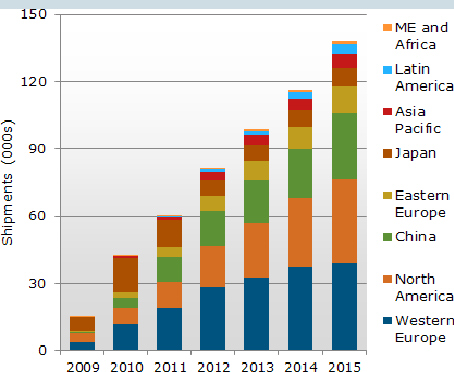 From the products launched by TV manufacturers in 2011, it can be seen that networked services are of vital importance to televisions. In 2011, more than 25% of flat-panel TVs will have networking capabilities. The DisplaySearch Q2'11 Quarterly TV Design and Features Report shows that by 2015, more than 138 million units will have networking capabilities, accounting for 47% of total flat-panel TV shipments. "Connected TV market is not limited to developed areas," said Paul Gray, director of television research at DisplaySearch. "Emerging markets tend to have very good broadcasting systems, and consumers are eager to have the best online programming resources."
From the products launched by TV manufacturers in 2011, it can be seen that networked services are of vital importance to televisions. In 2011, more than 25% of flat-panel TVs will have networking capabilities. The DisplaySearch Q2'11 Quarterly TV Design and Features Report shows that by 2015, more than 138 million units will have networking capabilities, accounting for 47% of total flat-panel TV shipments. "Connected TV market is not limited to developed areas," said Paul Gray, director of television research at DisplaySearch. "Emerging markets tend to have very good broadcasting systems, and consumers are eager to have the best online programming resources." DisplaySearch predicts that by the end of 2015, connected TV shipments will exceed 500 million units.
2015 India's DVB-T2 Digital Terrestrial Broadcasting Brings More Market Opportunities to Smart TVs
The government of India has recently introduced a policy to close the analogue land signal in 2015, thus enabling the DVB-T2 digital terrestrial broadcasting broadcasting standard. This move will pave the way for future television innovations and create important opportunities for the connected TV market.
At the same time, WiFi Direct makes it easier to connect televisions to handheld devices such as smartphones and tablets. DisplaySeach estimates that TV shipments with built-in 802.11 wireless networks will exceed 98 million units in 2015. "WiFi technology is the basic of smart TVs," Gray said. "We estimate that in 2015 North American market will have 35% of 46-inch and higher-size TVs as smart TVs, and have the following functions: It can obtain network resources without port restrictions; Intelligent search and recommendation function; self-upgrade function; interconnect with other devices to share network resources."
Energy-saving Supervision and Low Energy Consumption Drive LED Market Requirements
With the implementation of energy conservation regulatory policies and the gradual popularization of low energy consumption, LED-backlit TVs have obvious advantages. When changing TVs, consumers often consider low energy consumption to buy LED-backlit TVs. Although the prices of LED-backlit TVs are relatively high, for a low-end backlight TV, the energy-saving payback period in Canada is less than 4 years, while in Europe it is less than 2 years.
Gray continued: “This market research has been very clear, but surprisingly TV manufacturers have not actively marketed this. Consumers tend to choose low-fuel vehicles when they buy cars, DisplaySearch Global TV Replacement Study study shows that consumers are The energy consumption issue is also considered when buying a TV."
Educational Toys, Intellectual,Plastic Toys,Wooden Toys
BXCBDFH , http://www.nbrcdrone.com